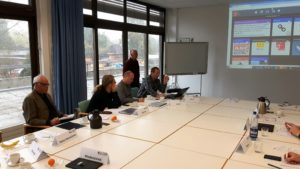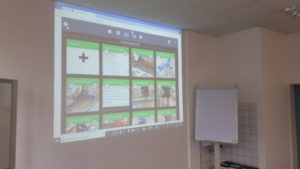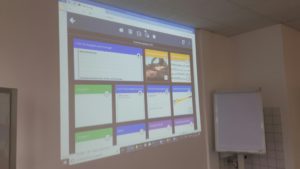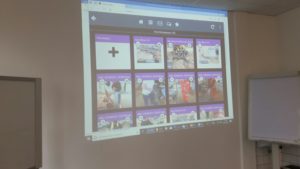Last week I returned from my long sick leave. And I had immediately the possibility to attend a working meeting at the training centre Bau-ABC Rostrup. With this training centre we had worked in the EU-funded Learning Layers project many years to develop digital tools to support work process -oriented learning. During the project we reached the stage that Learning Toolbox (LTB) was ready as a viable product to support training and learning processes. The pilot testing in the final phase of the project proved that trainers and apprentices can use the toolset in their training processes. Yet, there were several practical issues that slowed down a wider use of the LTB. Thus, the trainers that had been involved in the pilot testing kept on using the toolset but a wider use was delayed.
Now, in our meeting last week we were facing a new situation. In the meantime most of the hurdles had been overcome and there was full confidence among all parties involved that LTB can be introduced in the apprentice training of Bau-ABC for all trades, Now the pioneering trainers, the management/administration representatives and the LTB developers were discussing, how to support a full-scale implementation of the toolset. From this perspective there was a need to harmonise the use of LTB stacks across the trades and to ensure effective ICT support. Secondly, there was a need to create awareness of good practice in different trades and to share experiences across the trades. In this context the presence of us - researchers from the research institute ITB - was relevant, since we are working in TACCLE projects that support training of trainers and we can draw upon the work in Bau-ABC.
Insights into the uses of LTB to support training in different trades
Here it is not possible to give a complete overview of all the examples that were presented by Bau-ABC trainers representing different trades. Below, I have selected exemplary cases that show, how the use of LTB had been incorporated into the the work process -oriented learning projects of Bau-ABC apprentices:
- Pipeline-builders (Rohrleitungebauer) were using LTB to draft joint plans, how prepare the grounds for the pipelines. Instead of just doing the spadework individually, they made their plans as teams - they divided the tasks and allocated responsibilities for controlling.
- Road-builders (Strassenbauer) had prepared a comprehensive overview of the machines provided by the company W&N with nutshell versions of users' guides (based on the original materials).
- Tilers (Fliesenleger) had prepared a comprehensive overview of technical tools that were used in their trade with links to the instructions provided by the manufacturers.
- Construction plant operators (Baugeräteführer) had prepared electronic forms as checklists for the inspection of the vehicles before starting to use them. Only after completion of the form and reporting that the vehicles were in order the operators got clearance to start working.
- Carpenters (Zimmerer) had been working in a joint project "WorkCamp GreenHouse" with other training centres in Germany. In the project they had developed several modules for ecological construction work (focusing on their trade and the use of materials). In this project they had used LTB as a common toolset and developed a common project plan structure to guide the creation of mother stacks and daughter stacks.
- In the area "Health and Safety" (Arbeitssicherheit und Gesundheitsschutz) trainers from different trade had worked together to shape a common stack structure that presents the overarching regulations and the local instructions in the training centre. Within this structure different trades had the possibility to present trade-specific content (e.g. concerning their trade-specific personal safety outfits).
- In all trades the apprentices (Auszubildende) were using the LTB to upload photos as progress reports on their work and learning in the projects. The trainers used specific background colours for the tiles that documented apprentices' work.
The relevance of the recent progress for apprentice training and vocational learning
If the points that I have listed above are taken only as separate inputs with dedicated tools, it would not appear very "revolutionary". But the essence of the recent progress is that the trainers are working with an integrative digital toolset - the LTB. They have already used LTB for giving instructions and worksheets for apprentices' projects. Now, with these newer features the range of using LTB in working and learning contexts is expanding. And - as already mentioned - the trainers are themselves leading the innovation and sharing experience with each other. Moreover, for the apprentices the use of LTB is not just a matter of receiving instructions and reporting of the completion of their tasks. As we have seen it from the examples, the use of LTB requires from them a holistic view on their projects and a professional attitude to completion of the tasks. This has been the spirit of working with the LTB in Bau-ABC.
Now, at this stage we were happy to see that Bau-ABC is organising the wider use of the LTB independently of externally funded projects and within its own organisational frameworks - in collaboration with the LTB developers. And, moreover, Bau-ABC is looking for ways to spread the use of LTB across its professional networks. As we see it, the work of the Learning Layers project bears fruit! We - as accompanying researchers - are happy to observe this also in the future.
More blogs to come ...














